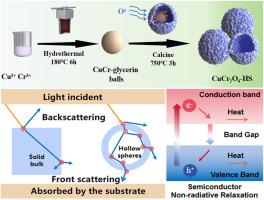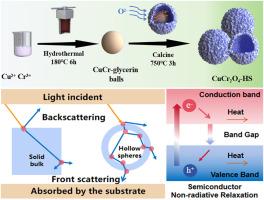Construction of broad-spectrum light absorption inorganic ultra-black coating with multi-scale light-absorbing structures based on hollow CuCr2O4 spheres
IF 9.7
2区 材料科学
Q1 MATERIALS SCIENCE, MULTIDISCIPLINARY
引用次数: 0
Abstract
Ultra-black coating can suppress stray light to ensure high-quality imaging of the spacecraft optical instruments. Currently, the mainly used coating is an organic ultra-black coating, which is easy to generate volatile substances at high temperatures, and contaminate the lens, leading to a decline in imaging quality. Therefore, it is urgent to develop a highly stable inorganic ultra-black coating. Herein, we developed all-inorganic coating composed of hollow CuCr2O4 microspheres (CuCr2O4-HS) and potassium silicate resin, which was fabricated through a spraying and self-assembly process. The solar absorptivity and average emissivity of CuCr2O4-HS coating (α = 96.26 %, ε = 92.21 %) is superior to that of commercial CuCr2O4-B coating (α = 94.43 %, ε = 88.79 %), and it shows a stable wide-angle absorption (up to an incident angle of 70°), which can be attributed to synergistic effects at both the nanoscale and molecular levels: (1) structural absorption resulting from multiple scattering within the CuCr2O4 HS spherical close-packed arrays; and (2) strong forward scattering and internal multiple scattering by individual hollow spherical particles, as well as intrinsic light absorption due to LOMO–HOMO orbital transitions within the CuCr2O4 particles. Moreover, the coatings also offer favorable thermal resistance (α = 96.06 %, ε = 92.08 % after exposure to 800 °C for 3 h), making them a promising candidate for ultra-black surfaces in hypersonic vehicles. The work provides a strategy for preparing a highly stable and ultra-black inorganic coating with wide-angle light absorption.


基于空心CuCr2O4球的多尺度吸光结构广谱无机超黑涂层的制备
超黑涂层可以抑制杂散光,保证航天器光学仪器的高质量成像。目前主要使用的涂层是有机超黑涂层,高温下容易产生挥发性物质,污染镜片,导致成像质量下降。因此,开发一种高稳定性的无机超黑涂层迫在眉睫。在此,我们开发了由空心CuCr2O4微球(CuCr2O4- hs)和硅酸钾树脂组成的全无机涂层,并通过喷涂和自组装工艺制备。CuCr2O4-HS涂层的太阳吸收率和平均发射率(α = 96.26%, ε = 92.21%)均优于商用CuCr2O4- b涂层(α = 94.43%, ε = 88.79%),且具有稳定的广角吸收(入射角可达70°),这是由于CuCr2O4-HS球形紧密排列阵列内部多次散射导致的结构吸收;(2)单个空心球形粒子的强前向散射和内部多重散射,以及CuCr2O4粒子内部LOMO-HOMO轨道跃迁引起的本征光吸收。此外,涂层还具有良好的耐热性(在800°C下暴露3小时后α = 96.06%, ε = 92.08%),使其成为高超声速飞行器超黑表面的有希望的候选材料。该工作为制备具有广角光吸收的高稳定超黑无机涂层提供了一种策略。
本文章由计算机程序翻译,如有差异,请以英文原文为准。
求助全文
约1分钟内获得全文
求助全文
来源期刊

Materials Today Physics
Materials Science-General Materials Science
CiteScore
14.00
自引率
7.80%
发文量
284
审稿时长
15 days
期刊介绍:
Materials Today Physics is a multi-disciplinary journal focused on the physics of materials, encompassing both the physical properties and materials synthesis. Operating at the interface of physics and materials science, this journal covers one of the largest and most dynamic fields within physical science. The forefront research in materials physics is driving advancements in new materials, uncovering new physics, and fostering novel applications at an unprecedented pace.
 求助内容:
求助内容: 应助结果提醒方式:
应助结果提醒方式:


